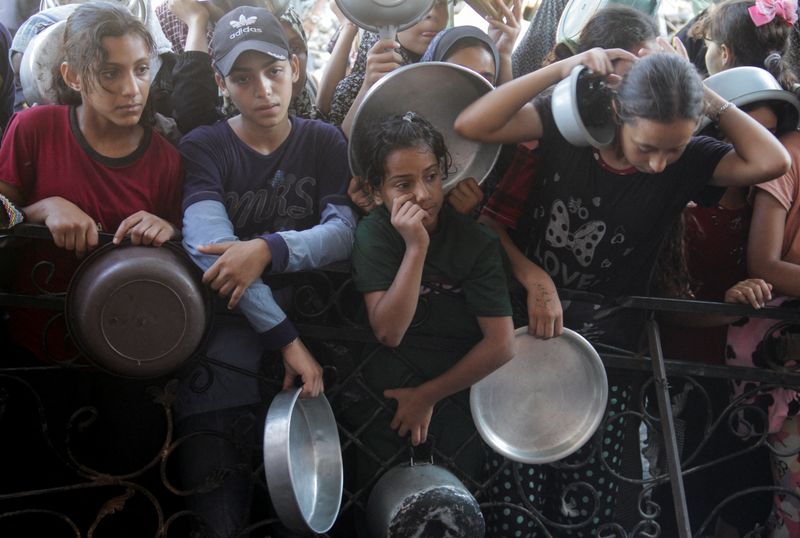By Lena Masri
(Reuters) -The entire Gaza Strip remains at risk of famine and is experiencing emergency levels of hunger, with intense Israeli military operations adding to concerns and hampering humanitarian access, a global monitor said on Thursday.
About 1.84 million people across the besieged Palestinian enclave are living through high levels of acute food insecurity, including nearly 133,000 people experiencing the most severe, or "catastrophic", levels, according to an analysis from the Integrated Food Security Phase Classification.
That is down from some 343,000 people suffering catastrophic hunger as of the last update in June, but it is expected to return to that level in coming months, the IPC said.
U.N. human rights chief Volker Turk described the assessment as "beyond terrifying."
"This crisis is principally the consequence of decisions made by the Israeli authorities. It is in their power to change the situation – urgently," he said, adding that starvation of civilians as a method of warfare constitutes a war crime.
The IPC noted an increase in food entering Gaza since May, but said humanitarian access began shrinking again in September.
"The risk of famine persists across the whole Gaza Strip. Given the recent surge in hostilities, there are growing concerns that this worst-case scenario may materialize," the IPC said in a summary of the analysis.
U.N. Secretary-General Antonio Guterres said he was alarmed by the IPC analysis.
"Famine looms. This is intolerable. Crossing points must open immediately, bureaucratic impediments must be removed, and law and order restored so U.N. agencies can deliver lifesaving humanitarian assistance," he said in an X social media post.
ACUTE MALNUTRITION
Israel's ally, the United States, told the U.N. Security Council on Wednesday it was watching to ensure Israel's actions on the ground show that it does not have a "policy of starvation" in the northern Gaza Strip.
An estimated 60,000 cases of acute malnutrition among young children were expected between September 2024 and August 2025, according to the IPC. The new analysis was conducted between Sept. 30 and Oct. 4.
Most of Gaza's 2.3 million inhabitants have been displaced, many of them multiple times, by more than a year of war between Israel and Palestinian militants Hamas. Israeli bombardment has left much of the territory in ruins.
The U.N. has long complained of obstacles to getting aid into Gaza and distributing it throughout the war zone, blaming impediments on Israel and lawlessness. The U.N. said no food aid entered northern Gaza from Oct. 2-15.
Israel says it does not stop aid from entering Gaza.
Reuters reported on Thursday that Israel had also stopped processing requests from traders to import food to Gaza, according to 12 people involved in the trade, choking off a crucial source of provisions.

The IPC is an initiative involving U.N. agencies, national governments and aid groups that sets the global standard on measuring food crises. The most extreme warning is Phase 5, which has two levels, catastrophe and famine.
The IPC defines famine as when at least 20% of people in an area are suffering extreme food shortages, with at least 30% of children acutely malnourished and two people out of every 10,000 dying daily from starvation or malnutrition and disease.